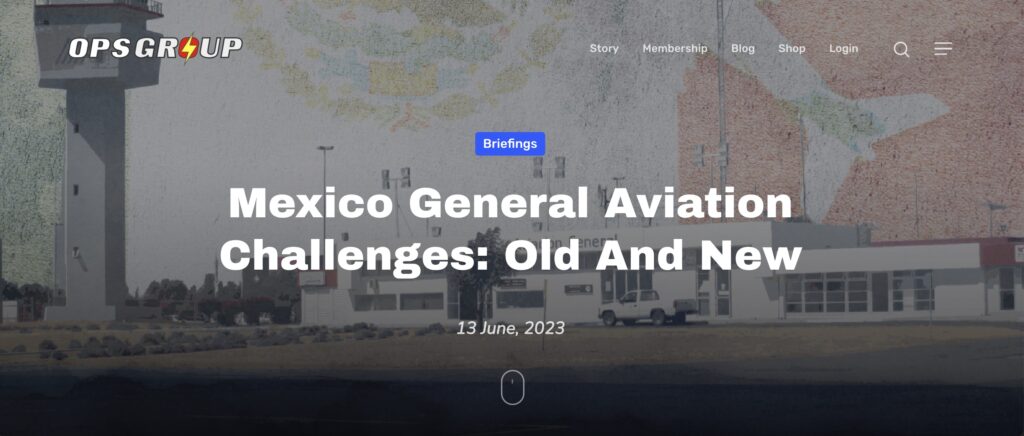Key Points
- Mexican Civil Aviation authorities have issued a new Mandatory Circular to their staff at Mexican airports which is causing confusion for both private and commercial flights.
- There are now different options for submitting APIS, including via email direct to the authorities, but some operators have faced issues with this.
Permit Confusion
Right on the heels of the implementation of the new Single Entry Authorization, known as an “AIU”, the Mexican Civil Aviation authority (AFAC) has issued a new Mandatory Circular which is causing issues at certain airports for BOTH Part 91 and Part 135 operations. Here’s the lowdown:
Issue #1: Private flights might get mis-identified as Commercial flights. The Circular claims that the “majority” of non-mexican registered aircraft indicate the type of service they are authorized to perform in their Registration or Airworthiness Certificates. Mexican registered aircraft identify their intended use through their tail number XA-Commercial, XB-Private, XC-Government. However, this claim in the circular could lead to an incorrect interpretation of Standard Airworthiness Certificates in the commuter, or transport categories to be an indication of the type of operation being performed. With this incorrect interpretation, a Private operation could be mis-interpreted to be a Commercial operation.
Issue #2: You need a noise certificate to get a landing permit. The minimum documents required now include a noise certificate. While required under 14 CFR 91.703 (a) (5) many pilots and operators do not know where to find it. In turboprop and turbojet aircraft, it is usually in the AFM. Smaller aircraft may need to create their own using the FAA Circulars AC 91-86 and AC_36-1H
Issue #3: You also need a Journey Logbook. An aircraft Journey Logbook is indicated as a required document. The aeroplane journey log should contain aeroplane nationality and registration, dates of flights, crew member names and duty assignments, departure and arrival points and times, purpose of flight, observations regarding the flight, signature of the pilot-in-command.
Issue #4: You also need Radio Station Licenses.Radio Station Licenses are now specifically required. While required under US law, many pilots/operators have chosen to ignore this and could be in for a harsh surprise.
Issue #5: Watch out for cabotage rules. Charter flights can only extract from Mexico those passengers that they brought in and cannot make any flights from one Mexican airport another.
Issue #6: You might need Mexican insurance for private flights. The circular states that the insurance policy for all aircraft must be a Mexican approved policy. It does not indicate that for private aircraft, the policies issued in their country of registry are accepted. This may be interpreted that ALL aircraft must now buy Mexican policies. More news to follow!
Issue #7: You might need a copy of the Mexican AIP. The circular states that the Aeronautical Information Publication (AIP) must be carried aboard in physical or electronic form. In the past, an equivalent document (Jeppesen Trip Kit) was accepted in lieu of the AIP. More news to follow!
Issue #8: You might need a review of your AOC. The circular states that for charter/freight/ambulance flights, a Mexican AOC must be obtained. There is no guidance on whether this is simply a review of the existing AOC of the operator or they actually want operators to undergo some new procedure to obtain a Mexican AOC. More news to follow!
The circular is sufficiently ambiguous and referring to numerous articles and sections of Mexican laws and Circulars that it will require a lot of homework to understand. As such, much appears to be left to interpretation which will most likely go against a pilot rather than to their benefit.
We recommend that you contact the civil aviation authorities at the Mexican airport of your intended arrival to determine what they are going to require of you.
If you are a Part 135 charter operator AND even if you have a blanket Mexican Charter Permit, you should contact your handler immediately to determine whether you will be allowed to operate at your intended Mexican airport of landing. We were informed that over the past weekend, well over a dozen charter flights were denied entry as a result of this Mandatory Circular.
Unfortunately, this Mandatory Circular is sufficiently vague that it is being handled differently airport to airport. However, we are receiving reports of charter flights being denied entry into Mexico at huge cost to all involved. We have not heard any reports yet regarding Part 91 but the ambiguity in this Circular leaves that door open as well. Just check in advance to avoid unpleasant surprises on arrival in Mexico.
APIS Options
Without getting too deep into the boring details, the bottom line is that there are now 3 ways to present Mexican APIS:
Option #1: ARINC. Per the 2013 Mexican Immigration APIS regulations, ARINC is the only authorized vendor for submitting a Mexican APIS manifest using the UN/EDIFACT standard. You can sign up directly with them for an account and submit through their portal.
Option #2: Email. The Mexican Immigration authorities have created an email address (apisinm@inami.gob.mx) to which you can send a properly completed and formatted Excel spreadsheet. To use this option you are limited to 4 trips to/from Mexico per year. If you exceed that number you need to find another option to submit your Mexican APIS. Some pilots have indicated receiving emails from Mexican Immigration indicating the 4 trip limit.
Pros: You don’t need to sign up for a paid service to comply.
Cons: The email address appears to be an email server which re-sends your email to the ARINC service but this email server does not return the response from the ARINC service. This means that you will not have proof whether your Excel file was successfully uploaded to ARINC or if it was rejected due to errors and never received by ARINC. This could set you up for a violation without even knowing it.
Option #3: A Third Party. You can use a third party service provider to submit your Mexican APIS. Some of these providers submit your APIS manifest directly through their account with ARINC outlined in point #1 above. Others submit your APIS manifest by sending the Excel file to the email address in point #2.
Other APIS Issues
Oct 2023: Mexican Immigration headquarters began sending internal circulars to their offices at international airports reminding the local Immigration officers that the Mexican APIS regulations existed and that they were to start warning private operators to comply or face enforcement actions. There were several more circulars sent between Nov 2023 and May 2024 with an ongoing the emphasis on enforcement action against private aircraft. Mexican Immigration has the ability to analyze the APIS data being submitted to the ARINC server in order to verify the accuracy and timeliness of the data you have submitted and determine compliance with the Mexican regulations.
Feb 2024: We began to hear of penalty cases being issued and fines being assessed on private operators for a number of issues. Of the specific cases where we were able to get factual information, some cases were the result of errors from manifests submitted through a third party app which never appeared on the ARINC server. In other cases, manifests submitted through the Mexican Immigration central email address were also not visible. All of this has created confusion for some operators and a number of Mexican Immigration officials at certain Mexican International airports have resorted to requesting copies of the Excel spreadsheet being sent to them via email which creates a risk of personally identifiable information being shared through insecure channels to unknown persons. Mexican Immigration headquarters has indicated in their last official communication that sending these emails is not necessary if you have complied with points 1, 2 or 3 above.
Mexico Ops: Other Recent Updates
Check below for more info on Mexico ops!
Jan 2024: Some recent changes to the permit procedures in Mexico have been causing stress and delays! Here’s how the new process works…
June 2023: A look at some of the long-standing challenges affecting General Aviation ops to Mexico, as well as some of the more recent issues which maybe haven’t been widely reported yet…
Thanks to Rick Gardner of CST Flight Services for this article. CST Flight Services provides a wide range of international trip support services in Mexico and beyond, for both owner-pilots and professional pilots. You can contact them for more info at: customersvc@cstflightservices.com
More on the topic:
- More: Mexico Permit Chaos: New Rules Explained
- More: Ops to Mexico? Prepare to get ramp checked!
- More: Mexico City Airport Safety Alert
- More: Mexico General Aviation Challenges: Old and New
- More: Mexico City says no to cargo
More reading:
- Latest: OPSGROUP is hiring! Wanted: Junior International Ops Specialist
- Latest: LOA Guide for US Operators
- Latest: NAT Ops: Flying the Blue Spruce Routes
- Safe Airspace: Risk Database
- Weekly Ops Bulletin: Subscribe
- Membership plans: Why join OPSGROUP?













 Get the famous weekly
Get the famous weekly 






What is the ARNIC Code to send to Mexico eAPIS
What about the LOPA and aircraft exterior picture requirements?
If the airplane has a radio license does the pilot need to have theirs